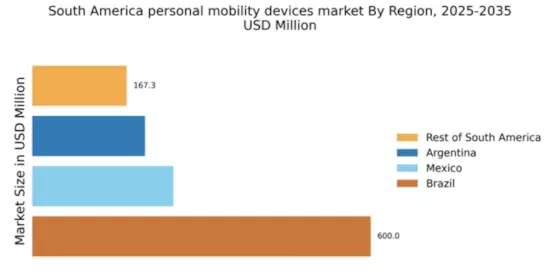Urbanization and Population Density
The rapid urbanization in South America is a crucial driver for the personal mobility-devices market. As cities expand and populations grow, the demand for efficient and compact transportation solutions increases. Urban areas are becoming more congested, leading to a need for alternatives to traditional vehicles. In 2025, urban areas in South America are projected to house over 80% of the population, creating a significant market for personal mobility devices. This trend indicates a shift towards smaller, more maneuverable devices that can navigate crowded streets. The personal mobility-devices market is likely to benefit from this urban-centric demand, as consumers seek solutions that offer convenience and efficiency in densely populated environments.
Rising Fuel Prices and Economic Factors
Economic conditions, particularly rising fuel prices, are influencing consumer behavior in South America, thereby impacting the personal mobility-devices market. As fuel costs continue to escalate, individuals are seeking cost-effective alternatives for transportation. The personal mobility-devices market is expected to see a notable increase in demand for devices that offer lower operational costs. In 2025, it is projected that the market will grow by 25% as consumers shift towards electric and non-fuel-based mobility solutions. This economic pressure is likely to drive innovation and affordability in the personal mobility-devices sector.
Government Initiatives and Policy Support
Government initiatives aimed at promoting sustainable transportation are playing a pivotal role in shaping the personal mobility-devices market in South America. Policies that encourage the use of electric vehicles and provide incentives for manufacturers are fostering a conducive environment for market growth. In 2025, various South American governments are expected to implement regulations that support the adoption of personal mobility devices, potentially increasing market penetration by 20%. This proactive approach by authorities not only enhances infrastructure but also boosts consumer confidence in the personal mobility-devices market.
Environmental Awareness and Sustainability
Growing environmental concerns among consumers in South America are driving the personal mobility-devices market. As awareness of climate change and pollution increases, individuals are seeking sustainable transportation options. The personal mobility-devices market is witnessing a shift towards eco-friendly solutions, such as electric scooters and bicycles. In 2025, it is estimated that the demand for electric mobility devices will rise by approximately 30%, reflecting a broader trend towards sustainability. This shift not only aligns with consumer preferences but also encourages manufacturers to innovate and develop greener technologies, further propelling the market forward.
Technological Advancements in Mobility Solutions
Technological innovations are significantly influencing the personal mobility-devices market in South America. The integration of advanced features such as GPS navigation, mobile app connectivity, and smart sensors enhances user experience and safety. In 2025, the market is expected to see a surge in devices equipped with smart technologies, which could account for nearly 40% of total sales. This trend suggests that consumers are increasingly valuing high-tech solutions that offer convenience and efficiency. The personal mobility-devices market is likely to evolve rapidly as manufacturers invest in research and development to meet these technological demands.


















Leave a Comment